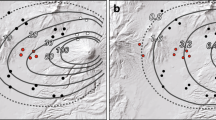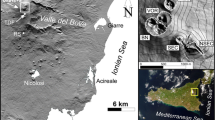Abstract
The calculation of volumes of fallout tephra layers is difficult because of the nonlinear dependence of thickness on area and because of the extrapolations required at the vent and in distal regions. Calculation using the trapezoidal rule, straight lines on log-log plots of area versus thickness, straight lines on plots of log thickness versus area1/2, and the crystal-concentration method are reviewed and the problems with each method discussed. The method using straight lines on plots of log thickness versus area1/2 is the most geologically reasonable because most deposits thin exponentially from source and therefore plot as straight lines using these coordinates. Errors and uncertainties in previous derivations for using this method are discussed and more general formulas presented. The method is also used to gain perspective on the “missing” distal volumes calculated by the crystal-concentration method compared to those calculated based only on isopach data.
Similar content being viewed by others
References
Drexler JW, Rose WI Jr, Sparks RSJ, Ledbetter MT (1980) The Los Chocoyos Ash, Guatemala: A major stratigraphic marker in Middle America and in three ocean basins. Quat Res 13:327–345
Fierstein J, Hildreth W (1992) The plinian eruptions of 1912 at Novarupta, Katmai National Park, Alaska. Bull Volcanol (in press)
Froggatt PC (1982) Review of methods of estimating rhyolitic tephra volumes; applications to the Taupo Volcanic Zone, New Zealand. J Volcanol Geotherm Res 14:301–318
Hayakawa Y (1985) Pyroclastic geology of Towada Volcano. Bull Earthquake Res Inst, U Tokyo 60:507–590
Hildreth W (1990) The 1932 plinian eruption of Quizapu, Chilean Andes (abstr). Abstract Volume, International Volcanological Congress, Mainz, September 3–8, 1990, International Association of Volcanology and Chemistry of the Earth's Interior
Pyle DM (1989) The thickness, volume and grainsize of tephra fall deposits. Bull Volcanol 51:1–15
Pyle DM (1990) New estimates for the volume of the Minoan eruption. Thera and the Aegean World III, 2, Earth Sciences, 113–121. London, The Thera Foundation
Rose WI Jr, Hoffman MF (1982) The May 18, 1980, eruption of Mount St. Helens: The nature of the eruption, with an atmospheric perspective. In: Deepak A (ed) Atmospheric effects and potential climatic impact of the 1980 eruptions of Mount St. Helens. Nat Aer and Space Admin, Conf Pub 2240, pp 1–14
Rose WJ Jr, Bonis S, Stoiber RE, Keller M, Bickford T (1973) Studies of volcanic ash from two recent Central American eruptions. Bull Volcanol 37:338–364
Sapper K (1904) Die vulcanischen Ereignisse in Mittelamerika im Jahre 1902. Neues Jahr Mineral Geol Palaeontol 1:39–90
Sarna-Wojcicki AM, Shipley S, Waitt RB Jr, Dzurisin D, Wood SH (1981) Areal distribution, thickness, mass, volume, and grain size of air-fall ash from the six major eruptions of 1980. In: Lipman PW, Mullineaux DR (eds) The 1980 Eruptions of Mount St. Helens, Washington. US Geol Surv Prof Pap 1250:577–600
Self S, Rampino MR, Newton MS, Wolff JA (1984) Volcanological study of the great Tambora eruptions of 1815. Geology 12:659–663
Sparks RSJ, Wilson L, Sigurdsson H (1981) The pyroclastic deposits of the 1875 eruption of Askja, Iceland. Phil Trans R Soc Lond 299:241–273
Sussman D (1985) Apoyo caldera, Nicaragua: A major Quaternary silicic eruptive center. J Volcanol Geotherm Res 24:249–282
Thorarinsson S (1954) The tephra-fall from Hekla on March 29tg 1947, in The eruption of Hekla 1947–1948 II, 3. Societas Scientiarium Islandica, Reykjavik
Thorarinsson S, Sigvaldason GE (1972) The Hekla eruption of 1970. Bull Volcanol 36:269–288
Walker GPL (1980) The Taupo pumice: Product of the most powerful known (ultraplinian) eruption? J Volcanol Geotherm Res 8:69–94
Walker GPL (1981) The Waimihia and Hatepe plinian deposits from the rhyolitic Taupo Volcanic Centre. N Z J Geol Geophys 24:305–324
Walker GPL, Croasdale R (1971) Two Plinian-type eruptions in The Azores. J Geol Soc Lond 127:17–55
Williams SN, Self S (1983) The October 1902 plinian eruption of Santa María volcano, Guatemala. J Volcanol Geotherm Res 16:33–56
Author information
Authors and Affiliations
Rights and permissions
About this article
Cite this article
Fierstein, J., Nathenson, M. Another look at the calculation of fallout tephra volumes. Bull Volcanol 54, 156–167 (1992). https://doi.org/10.1007/BF00278005
Received:
Accepted:
Issue Date:
DOI: https://doi.org/10.1007/BF00278005




